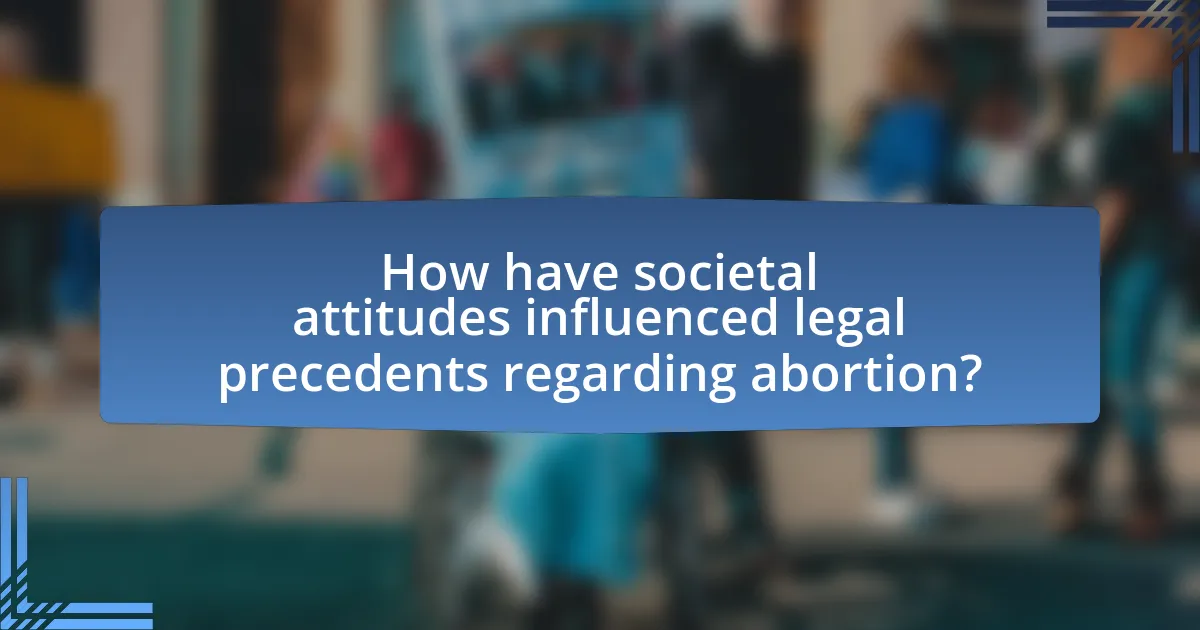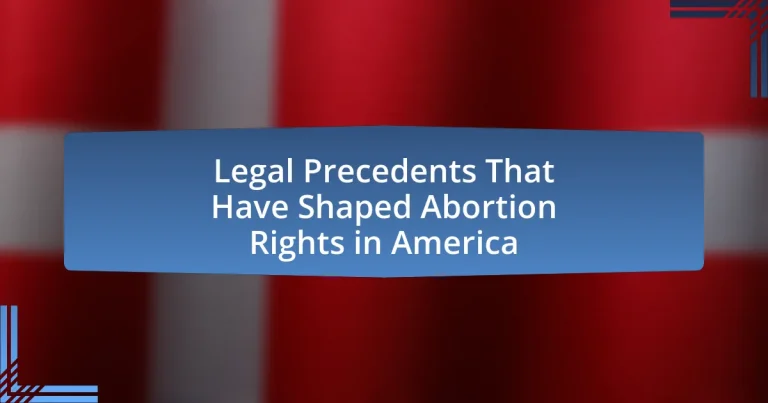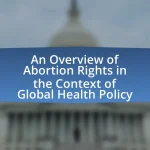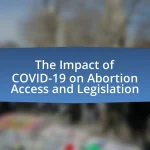The article examines the key legal precedents that have shaped abortion rights in America, focusing on landmark cases such as Roe v. Wade (1973), Planned Parenthood v. Casey (1992), and Whole Woman’s Health v. Hellerstedt (2016). It outlines how Roe v. Wade established a woman’s constitutional right to choose an abortion, while subsequent cases reaffirmed and clarified this right, allowing for certain state regulations without imposing undue burdens. The discussion also highlights the impact of societal attitudes, historical context, and recent legislative changes on the evolving landscape of abortion rights, emphasizing the ongoing influence of legal precedents on access to abortion services today.

What are the key legal precedents that have shaped abortion rights in America?
The key legal precedents that have shaped abortion rights in America include Roe v. Wade (1973), Planned Parenthood v. Casey (1992), and Whole Woman’s Health v. Hellerstedt (2016). Roe v. Wade established a woman’s legal right to choose an abortion under the constitutional right to privacy, effectively legalizing abortion nationwide. Planned Parenthood v. Casey reaffirmed Roe’s core holding while allowing states to impose certain restrictions, provided they do not place an “undue burden” on a woman’s right to choose. Whole Woman’s Health v. Hellerstedt further clarified that states cannot impose regulations that create substantial obstacles for women seeking abortions, reinforcing the protections established in Roe and Casey. These cases collectively form the legal foundation for abortion rights in the United States.
How did the landmark case Roe v. Wade influence abortion rights?
The landmark case Roe v. Wade established a woman’s legal right to choose an abortion, significantly influencing abortion rights in the United States. Decided in 1973, the Supreme Court ruled that the right to privacy under the Due Process Clause of the Fourteenth Amendment extends to a woman’s decision to terminate her pregnancy. This ruling invalidated many state laws that restricted access to abortion, thereby setting a legal precedent that protected abortion rights and shaped subsequent legal battles and legislation surrounding reproductive health. The decision has been cited in numerous cases and remains a foundational element in the ongoing discourse about abortion rights in America.
What were the main arguments presented in Roe v. Wade?
The main arguments presented in Roe v. Wade centered around the right to privacy and the state’s interest in regulating abortions. The Supreme Court ruled that the right to privacy, derived from the Due Process Clause of the Fourteenth Amendment, encompasses a woman’s decision to terminate her pregnancy. This decision established that states could not impose excessive restrictions on abortion during the first trimester, balancing the woman’s right to privacy with the state’s interests in protecting maternal health and potential life. The ruling highlighted that the state’s interest in regulating abortions becomes stronger as the pregnancy progresses, allowing for more restrictions in the second and third trimesters.
How did the Supreme Court’s decision in Roe v. Wade impact state laws?
The Supreme Court’s decision in Roe v. Wade established a constitutional right to abortion, significantly impacting state laws by invalidating many existing state restrictions on abortion. This landmark ruling, decided in 1973, determined that states could not impose undue burdens on a woman’s right to choose, leading to the invalidation of laws that banned abortion outright or imposed strict regulations. As a result, states were required to align their laws with the constitutional protections affirmed by the Court, which fundamentally altered the legal landscape surrounding abortion rights in the United States.
What role did Planned Parenthood v. Casey play in abortion rights evolution?
Planned Parenthood v. Casey significantly reinforced abortion rights in the United States by upholding the core holding of Roe v. Wade while allowing states to impose certain restrictions. The 1992 Supreme Court decision affirmed that the right to have an abortion is constitutionally protected, emphasizing that states cannot place an “undue burden” on a woman’s right to choose. This ruling established a new standard for evaluating state laws regarding abortion, which has since influenced numerous legal challenges and legislative actions surrounding reproductive rights. The decision also highlighted the importance of women’s autonomy in making personal medical decisions, thereby shaping the ongoing discourse and legal landscape of abortion rights in America.
What were the significant outcomes of Planned Parenthood v. Casey?
The significant outcomes of Planned Parenthood v. Casey include the reaffirmation of the constitutional right to have an abortion and the establishment of the “undue burden” standard for evaluating state restrictions on abortion. The Supreme Court’s decision in 1992 upheld the core holding of Roe v. Wade while allowing states to impose certain regulations, provided they do not place an undue burden on a woman’s right to choose. This ruling clarified that while states can regulate abortions, they cannot enact laws that significantly obstruct access to abortion services, thus shaping the legal landscape of abortion rights in America.
How did this case modify the standards set by Roe v. Wade?
The case of Planned Parenthood v. Casey modified the standards set by Roe v. Wade by affirming the constitutional right to have an abortion while allowing states to impose certain restrictions. Specifically, the Supreme Court upheld the core holding of Roe that women have a right to choose to have an abortion before fetal viability but introduced the “undue burden” standard, which permits states to regulate abortions as long as those regulations do not place substantial obstacles in the path of a woman seeking an abortion before viability. This decision effectively allowed for more state-level restrictions on abortion access while maintaining the fundamental right established in Roe v. Wade.
What other significant cases have influenced abortion rights?
Significant cases that have influenced abortion rights include Planned Parenthood v. Casey (1992), which upheld the core holding of Roe v. Wade while allowing states to impose certain restrictions, and Whole Woman’s Health v. Hellerstedt (2016), which struck down Texas regulations that created undue burdens on women seeking abortions. These cases reinforced the legal framework surrounding abortion rights in the United States, establishing precedents that balance state interests with women’s rights to access abortion services.
How did Whole Woman’s Health v. Hellerstedt affect abortion clinic regulations?
Whole Woman’s Health v. Hellerstedt significantly affected abortion clinic regulations by striking down Texas laws that imposed strict requirements on abortion facilities and physicians. The Supreme Court ruled that these regulations placed an unconstitutional burden on a woman’s right to access abortion services, as they did not provide any significant health benefits. The decision emphasized that regulations must be based on medical evidence and not create unnecessary obstacles for women seeking abortions, thereby reinforcing the standard that states cannot impose undue burdens on access to abortion.
What implications did Gonzales v. Carhart have on late-term abortion laws?
Gonzales v. Carhart upheld the Partial-Birth Abortion Ban Act of 2003, which significantly impacted late-term abortion laws by affirming the government’s ability to restrict certain abortion procedures. The Supreme Court’s decision indicated that states could impose regulations on abortion methods, even if those regulations could limit access to abortion services. This ruling set a precedent that allowed for more stringent state-level restrictions on late-term abortions, influencing subsequent legislation in various states aimed at limiting abortion access. The case demonstrated the Court’s willingness to prioritize state interests in regulating medical procedures over the rights of women to access specific abortion methods, thereby reshaping the legal landscape surrounding late-term abortion in the United States.

How have societal attitudes influenced legal precedents regarding abortion?
Societal attitudes have significantly influenced legal precedents regarding abortion by shaping public opinion and legislative actions that ultimately affect judicial decisions. For instance, the landmark Supreme Court case Roe v. Wade in 1973 was a direct reflection of the growing acceptance of women’s rights and reproductive autonomy during the 1960s and 1970s, a period marked by feminist movements advocating for gender equality. This societal shift prompted the Court to recognize a woman’s right to choose as a constitutional right under the right to privacy. Furthermore, subsequent cases, such as Planned Parenthood v. Casey in 1992, demonstrated how evolving societal views on abortion rights led to the reaffirmation of Roe while allowing states to impose certain regulations, indicating that legal interpretations are often responsive to prevailing public sentiments.
What historical context led to the establishment of abortion rights in America?
The historical context that led to the establishment of abortion rights in America includes the changing societal attitudes towards women’s rights and reproductive autonomy, particularly during the late 19th and 20th centuries. In the 1960s, the feminist movement gained momentum, advocating for women’s control over their bodies and reproductive choices. This culminated in the landmark Supreme Court case Roe v. Wade in 1973, which recognized a woman’s constitutional right to privacy, thereby legalizing abortion nationwide. The decision was influenced by earlier cases that established privacy rights, such as Griswold v. Connecticut in 1965, which struck down laws prohibiting contraceptive use. These shifts in legal and social perspectives laid the groundwork for the recognition of abortion rights in America.
How did the women’s rights movement impact abortion legislation?
The women’s rights movement significantly influenced abortion legislation by advocating for women’s autonomy over their reproductive choices. This activism culminated in landmark legal decisions, most notably Roe v. Wade in 1973, which established a woman’s legal right to choose an abortion under the right to privacy. The movement’s efforts included organizing protests, raising public awareness, and lobbying for legislative changes, which collectively pressured lawmakers to reconsider restrictive abortion laws. As a result, the movement not only shaped public opinion but also led to legal frameworks that recognized and protected reproductive rights, fundamentally altering the landscape of abortion legislation in the United States.
What societal changes have influenced public opinion on abortion?
Societal changes such as the women’s rights movement, increased access to education, and shifts in religious attitudes have significantly influenced public opinion on abortion. The women’s rights movement, particularly in the 1960s and 1970s, advocated for reproductive rights, leading to greater public awareness and support for abortion access. Increased access to education, especially for women, has correlated with more progressive views on reproductive health, as educated individuals tend to support abortion rights more than those with less education. Additionally, changing religious attitudes, with some denominations becoming more accepting of abortion, have contributed to a shift in public opinion, as seen in surveys indicating that younger generations are more likely to support abortion rights compared to older generations. These societal changes reflect a broader cultural shift towards individual autonomy and reproductive rights.
How do current events shape the future of abortion rights in America?
Current events significantly influence the future of abortion rights in America by shaping public opinion, legislative actions, and judicial decisions. For instance, the Supreme Court’s decision in Dobbs v. Jackson Women’s Health Organization in 2022 overturned Roe v. Wade, leading to a patchwork of state laws that either restrict or protect abortion access. This shift has prompted various states to enact laws that reflect their political climates, with some states moving to protect abortion rights through legislation or ballot measures, while others impose stricter regulations. Additionally, ongoing public protests and advocacy efforts highlight the societal demand for reproductive rights, which can sway political leaders and influence future legal battles. The interplay of these current events creates a dynamic landscape that will continue to evolve, impacting the legal precedents surrounding abortion rights in America.
What recent legislative changes have been proposed or enacted?
Recent legislative changes regarding abortion rights in America include the enactment of laws in several states aimed at restricting access to abortion services. For instance, in 2023, states like Texas and Florida passed laws that impose stricter regulations on abortion providers and limit the circumstances under which abortions can be performed. These changes reflect a broader trend following the Supreme Court’s decision in Dobbs v. Jackson Women’s Health Organization, which overturned Roe v. Wade, allowing states to set their own abortion laws. The implications of these legislative changes are significant, as they directly impact women’s reproductive rights and access to healthcare across the country.
How do Supreme Court nominations affect abortion rights discussions?
Supreme Court nominations significantly influence abortion rights discussions by determining the ideological balance of the Court, which directly affects rulings on abortion-related cases. For instance, the appointment of justices who lean conservative can lead to the overturning of precedents like Roe v. Wade, as seen with the 2022 decision in Dobbs v. Jackson Women’s Health Organization, which effectively dismantled federal protections for abortion rights. This shift prompts intense public debate and mobilization around abortion access, as stakeholders respond to the changing legal landscape shaped by the Court’s composition.

What are the implications of legal precedents on abortion rights today?
Legal precedents significantly influence abortion rights today by establishing the framework within which courts interpret and enforce these rights. The landmark case Roe v. Wade (1973) recognized a woman’s constitutional right to privacy, which includes the right to choose an abortion, setting a legal standard that has shaped subsequent rulings. However, the recent overturning of Roe v. Wade by the Supreme Court in Dobbs v. Jackson Women’s Health Organization (2022) has led to a patchwork of state laws, with some states enacting strict bans while others protect abortion rights. This shift illustrates how legal precedents can directly affect access to abortion services, creating disparities based on geographic location and state legislation.
How do legal precedents affect access to abortion services?
Legal precedents significantly influence access to abortion services by establishing the legal framework within which states can regulate abortion. For instance, the landmark Supreme Court case Roe v. Wade (1973) recognized a woman’s constitutional right to choose an abortion, thereby limiting states’ ability to impose restrictive laws. Subsequent cases, such as Planned Parenthood v. Casey (1992), upheld Roe but allowed states to implement certain regulations, which has led to varying levels of access across different states. These precedents create a legal environment that can either protect or restrict access to abortion services, depending on how courts interpret and apply them.
What barriers to access have emerged in recent years?
Recent years have seen significant barriers to access for abortion services, primarily due to restrictive state laws and regulations. For instance, many states have enacted laws that impose waiting periods, mandatory counseling, and parental consent requirements, which can delay or prevent access to abortion. According to the Guttmacher Institute, as of 2023, 26 states have passed laws that significantly limit access to abortion, including bans after a certain gestational age and requirements for clinics to meet hospital-like standards, which are often difficult to achieve. These barriers disproportionately affect low-income individuals and those living in rural areas, further exacerbating inequalities in access to reproductive healthcare.
How do state-level laws vary in response to federal precedents?
State-level laws vary significantly in response to federal precedents, particularly in the context of abortion rights. Following the Supreme Court’s decision in Roe v. Wade (1973), which established a woman’s legal right to an abortion, many states enacted laws that either aligned with or sought to restrict this federal precedent. For instance, some states implemented regulations such as waiting periods and parental consent laws, while others passed more restrictive measures, including outright bans or severe limitations on abortion access, often citing state interests in protecting fetal life. This divergence illustrates how states interpret and respond to federal rulings, leading to a patchwork of laws across the country. The ongoing legal battles, such as those seen in cases like Whole Woman’s Health v. Hellerstedt (2016) and more recent challenges post-Dobbs v. Jackson Women’s Health Organization (2022), further exemplify how state legislatures actively shape their laws in reaction to federal judicial decisions, resulting in varied access to abortion services based on geographic location.
What can individuals do to advocate for abortion rights?
Individuals can advocate for abortion rights by engaging in grassroots activism, supporting relevant organizations, and participating in public discourse. Grassroots activism includes organizing or joining rallies, marches, and campaigns that promote reproductive rights, which can mobilize community support and raise awareness. Supporting organizations such as Planned Parenthood or the National Abortion Federation provides financial resources and volunteer efforts that strengthen advocacy initiatives. Additionally, participating in public discourse through social media, writing letters to elected officials, or sharing personal stories can influence public opinion and policy decisions. According to a 2021 report by the Guttmacher Institute, states with higher levels of public advocacy and organized support for abortion rights tend to have more protective laws in place, demonstrating the impact of individual actions on legislative outcomes.
How can grassroots movements influence legal changes regarding abortion?
Grassroots movements can influence legal changes regarding abortion by mobilizing public opinion, advocating for policy reforms, and directly engaging with lawmakers. These movements often raise awareness about abortion rights issues, leading to increased public support, which can pressure legislators to enact or amend laws. For instance, the Women’s March in 2017 galvanized millions to advocate for reproductive rights, contributing to legislative discussions and influencing the political landscape. Additionally, grassroots organizations like Planned Parenthood and the National Organization for Women have historically played pivotal roles in lobbying for reproductive rights, demonstrating that sustained grassroots activism can lead to significant legal changes, as seen in the expansion of access to abortion services in various states.
What resources are available for those seeking to understand their rights?
Legal aid organizations, government websites, and educational resources are available for those seeking to understand their rights. Organizations such as the American Civil Liberties Union (ACLU) provide comprehensive information on civil rights, including abortion rights, while government websites like the U.S. Department of Justice offer legal guidelines and protections. Additionally, educational platforms and legal clinics often provide workshops and materials that explain individual rights in the context of abortion laws, ensuring individuals have access to accurate and relevant information.


